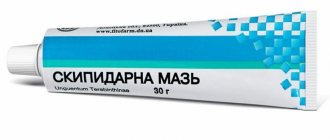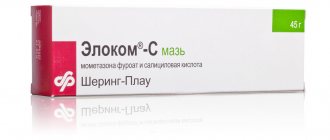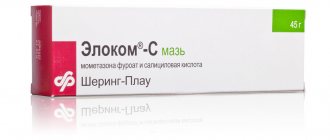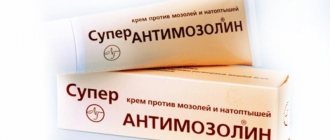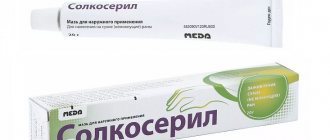Pharmacodynamics
Tacrolimus belongs to the group of calcineurin inhibitors. It binds to a specific cytoplasmic protein immunophilin (FKBP12), which is a cytosolic receptor for calcineurin (FK506). As a result, a complex is formed that includes tacrolimus, FKBP12, calcium, calmodulin and calcineurin, which leads to inhibition of the phosphatase activity of calcineurin. This makes it impossible to dephosphorylate and translocate the nuclear factor of activated T cells (NFAT), which is necessary to initiate transcription of genes encoding the production of cytokines key to the T-cell immune response (IL-2 and interferon-gamma). In addition, tacrolimus inhibits the transcription of genes encoding the production of cytokines such as IL-3, IL-4, IL-5, granulocyte-macrophage colony-stimulating factor (GMCSF) and TNF-α, which are involved in the initial stages of T-lymphocyte activation. In addition, under the influence of tacrolimus, the release of inflammatory mediators from mast cells, basophils and eosinophils is inhibited, as well as the expression of FcεRI (high-affinity surface receptor for IgE) on Langerhans cells is reduced, which leads to a decrease in their activity and antigen presentation to T lymphocytes.
Tacrolimus ointment does not affect collagen synthesis, etc. does not cause skin atrophy.
The appearance in clinical practice of fundamentally new topical drugs with selective immunosuppressive activity has become an event comparable to the introduction of topical corticosteroid (CS) drugs into practice. Over the past decade, topical calcineurin inhibitors have been successfully used abroad and in Russia, which have pronounced anti-inflammatory properties and do not have the side effects characteristic of external CS.
One such drug is tacrolimus ( Protopic
) is a non-steroidal cell-selective inhibitor belonging to the class of ascomycin macrolactams. The main effect of tacrolimus is due to inhibition of the phosphatase activity of calcineurin, which makes it impossible to dephosphorylate and translocate into the cell nucleus the nuclear factor of activated T cells (NFAT), which is necessary to initiate the transcription of genes encoding the production of cytokines key to the T-cell immune response (IL-2 and gamma -interferon). In addition, tacrolimus inhibits the transcription of genes encoding the production of cytokines such as IL-3, IL-4, IL-5, IL-8, IL-10; granulocyte-macrophage colony-stimulating factor and tumor necrosis factor, which take part in the initial stages of T-lymphocyte activation. At the same time, tacrolimus suppresses the expression of high-affinity Fc&egr;RI receptors by Langerhans cells and prevents the degranulation of mast cells, basophils and eosinophils, and the formation of proinflammatory cytokines, reducing the expression of intercellular adhesion molecules-1 and E-selectin during vascular damage. At the same time, tacrolimus does not affect collagen synthesis, does not cause vasoconstriction and suppresses the activation of Langerhans cells, which distinguishes its mechanism of action from that of CS [1, 2].
An important component of the use of immunosuppressive drugs, in particular calcineurin inhibitors, is their possible connection with an increased risk of developing cancer. Such information was indeed published by the US FDA (2005), but it concerned the systemic use of calcineurin inhibitors and did not apply to topical drugs. Moreover, controlled randomized trials have shown that the use of topical calcineurin inhibitors is associated with a lower likelihood of developing non-melanocytic cancer and skin lymphomas than placebo and topical CS [3, 4].
Thus, calcineurin inhibitors are immunomodulatory drugs that can penetrate the skin and, when applied externally, do not lead to either the adverse reactions characteristic of CS or the general immunosuppression characteristic of systemic immunosuppressants [5].
Of course, such a wide range of mechanisms of action and the proven safety of tacrolimus make it possible to use it in clinical practice for various chronic skin diseases that are immune-dependent. The leading role of immune-mediated inflammation in pathogenesis is characteristic of many diseases: atopic dermatitis, eczema, psoriasis, vitiligo, limited scleroderma and many others. All of these dermatoses are steroid-sensitive, but in recent years a torpid course, resistant to traditional therapy, as well as predicted local and systemic side effects of CS drugs, have been quite often observed. Steroidophobia should also be taken into account. All this leads to the search for new effective and at the same time safe agents with anti-inflammatory and immunosuppressive properties and high compliance. It should be understood that the question of a complete replacement of CS drugs is not yet raised - we are only talking about a possible comparable alternative, which is so necessary in clinical practice, especially in children, as well as when the process is localized in areas of the skin with increased sensitivity.
Today, tacrolimus is widely used for atopic dermatitis, and its high efficacy and safety have been proven in numerous controlled randomized studies [5, 6]. Indications for the prescription of tacrolimus are atopic dermatitis in children (from 2 years of age) and adults with mild, moderate and severe course of the process, both in short courses and for long-term control of the disease (12 months) [7, 8]. Moreover, the effectiveness of tacrolimus is comparable to strong topical CS (class III according to the European classification) and superior to pimecrolimus (another calcineurin blocker), as well as weak and moderately active CS (class I-II) [9, 10].
In recent years, the effectiveness of tacrolimus in other immune-mediated steroid-sensitive diseases has been actively studied. Data from a review of the literature, and in most cases these are clinical studies, have shown that tacrolimus is highly effective for a number of dermatoses. And although in some studies the expectations turned out to be higher than the results obtained, this direction is very promising and requires a longer time to analyze the experience gained. Below is information about the use of tacrolimus for various dermatoses. Despite the fact that in some cases these data are in the nature of isolated clinical observations, they, in our opinion, can become a certain guide for further scientific research.
Studies on the effectiveness and safety of tacrolimus in accordance with the evidence base of levels A and B, in addition to atopic dermatitis, are available for the following diseases: inverse and seborrheic psoriasis, seborrheic dermatitis, contact dermatitis, chronic eczema of the hands, erosive form of lichen planus, vitiligo. Studies for other diseases listed in this article have an evidence base of C, or are in the nature of isolated observations, which requires further study.
Psoriasis
The standard for external treatment of psoriasis is topical CS and calcipotriol, while the former, in addition to side effects, are characterized by the development of tachyphylaxis and withdrawal syndrome; Calcipotriol has an irritating effect and is not used for lesions of the face, folds, or pustular psoriasis. The use of tacrolimus for psoriasis is pathogenetically justified in inverse (localized in skin folds, on the genitals) and seborrheic psoriasis (localized on the face, ears, neck), when the use of CS or calcipotriol is limited. The 0.1% ointment is highly effective, which makes it the drug of choice for these clinical types of psoriasis [11, 12]. At the same time, there is information about positive results of treatment of patients with a generalized form of pustular psoriasis, refractory to CS therapy [13]. In other forms, the lack of effectiveness can be explained by the fact that, being a rather large molecule, tacrolimus does not sufficiently penetrate plaques with severe hyperkeratosis.
Seborrheic dermatitis
An important factor in the development and maintenance of the inflammatory process in seborrheic dermatitis is the colonization of Pityrosporum ovale
and
Malassezia furfur
. Against the latter pathogen, tacrolimus has an antifungal effect. When the process is localized on the skin of the face or scalp, tacrolimus causes a pronounced positive effect on the clinical symptoms of dermatosis in both moderate and severe cases, which is confirmed by the results of randomized placebo-controlled studies [14, 15]. The therapeutic effect of tacrolimus compared to that of CS drugs is more delayed (2 weeks), but the overall therapeutic effectiveness is comparable. There is also data on the preventive effect of 0.1% tacrolimus ointment for seborrheic dermatitis during remission, including when used in an intermittent manner (1-3 times a week), which allows for long-term control of the disease [16]. Thus, in the foreseeable future, tacrolimus may become an alternative treatment for seborrheic dermatitis to CS drugs.
Contact dermatitis
The main studies on the effectiveness of tacrolimus for contact dermatitis concern patients with nickel allergy. Publications on the effectiveness and safety of the drug for dermatitis caused by other triggers are sporadic, which means that further study of this problem is necessary. For nickel contact dermatitis, the effectiveness of 0.1% tacrolimus ointment is comparable to the effect of strong CS drugs, however, the possibility of long-term use and the absence of side effects allow it to be considered a first-line drug in the treatment of nickel contact dermatitis [17].
Chronic eczema of the hands
The widespread prevalence of chronic hand eczema and its constantly relapsing course necessitate the search for new effective external treatments. The main trigger factors for dermatosis are irritants and allergens, which, as a rule, cannot be completely eliminated, therefore, immune-mediated inflammation of varying severity is constantly observed in the skin, which, in turn, requires long-term use, in particular, of CS drugs. A study of the use of 0.1% tacrolimus ointment for hand eczema showed the greatest effectiveness with applications 2-3 times a day, in some cases under occlusion, while systemic absorption is minimal and does not differ from that when using the drug without occlusion, which indicates safety this technique [18].
Lichen planus
Lichen planus affecting the oral mucosa is quite difficult to treat. In this regard, reports of the effectiveness of the use of calcineurin inhibitors, including for erosive and ulcerative lesions, are very encouraging [19]. The pathogenetic nature, safety, and possibility of long-term use predetermine the very promising therapeutic prospects of tacrolimus for this dermatosis. However, there is evidence of an increase in the level of tacrolimus in the systemic circulation after prolonged applications to the oral mucosa. This issue requires further study.
Vitiligo
Vitiligo is an autoimmune chronic disease. Various phototherapy methods are most effective for vitiligo, but repigmentation is observed in 30-50% of cases, and the results achieved in half of the cases are transient. Recent data contain information on the effectiveness of the use of tacrolimus (repigmentation more than 70%) in the treatment of vitiligo as part of complex treatment. It is believed that the use of tacrolimus can promote skin repigmentation with an effectiveness comparable to CS drugs, with the best results observed when the process is localized on the skin of the face [15, 20]. When combined with an excimer laser or narrowband mid-wave (311 nm) ultraviolet therapy, the effectiveness is significantly increased [20, 21].
Lichen sclerosus
Currently, the study of the mechanisms of development of lichen sclerosus, the nature of its various clinical forms, and the effectiveness of complex therapy continues. At the same time, a number of authors consider the disease as an independent nosological form, different from localized scleroderma and the atrophic form of lichen planus, while other researchers consider it a type of scleroderma. In any case, the localization of the process on the mucous membrane of the external genitalia and subjective complaints significantly reduce the quality of life of this category of patients. Treatment of patients with lichen sclerosus of anogenital localization is long-term, which limits the use of CS drugs. According to the results of studies, the use of low concentrations of 0.03% tacrolimus ointment in children 1-2 times a day for 16 weeks, and then 2 times a week for up to 10 months with lichen sclerosus of anogenital localization helps achieve clinical remission [22]. In adult patients, it is recommended to use 0.1% tacrolimus ointment 2 times a day for 6-16 weeks, while the effectiveness is comparable to CS drugs, and the duration of remission is 24 weeks [23, 24].
Rosacea
Rosacea is a disease of vascular origin, predominantly of the facial skin, characterized by a chronic progressive course and refractory to therapy. Currently, there is evidence of the pathogenetic significance of immune system disorders in the form of a decrease in the number of T-suppressors and increased expression of pro-inflammatory cytokines. Based on these data, it is clear that tacrolimus has therapeutic potential for rosacea [25, 26].
A special form of this disease is steroid-induced rosacea, which develops as a result of long-term use of topical CS. Data from studies on the use of tacrolimus in combination with systemic antibiotics in patients who used external CS for 1 month to 20 years showed the high effectiveness of the combined technique and allowed the authors to propose this combination as the method of choice for steroid rosacea [15, 27].
In light of these data, the experience of using tacrolimus, for example, according to an intermittent regimen, when discontinuing CS drugs in order to prevent withdrawal syndrome, may be promising.
lupus erythematosus
The standard treatment for cutaneous forms of lupus erythematosus is external fluoridated CS, long-term use of which is associated with the development of predictable side effects.
In this regard, calcineurin inhibitors may represent a definite alternative to CS. The mechanism of action of tacrolimus, aimed at suppressing immune-mediated inflammation in the skin, and the lack of influence on collagen synthesis allow its successful and long-term use for the treatment of various clinical forms of lupus erythematosus. Applications of 0.1% tacrolimus ointment 2 times a day are effective in the treatment of skin lesions resistant to standard therapies in subacute and systemic lupus erythematosus [28, 29]. However, in discoid lupus erythematosus, the effectiveness was significantly lower than might be expected: apparently, this is due to insufficient penetration of the drug into the lesions, which is hampered by severe follicular hyperkeratosis [30].
A large amount of data on the use of tacrolimus in the treatment of various dermatoses that have appeared in recent years does not allow one review to cover all nosologies, and therefore in the table
the most significant, potentially promising indications for the use of tacrolimus in dermatology are presented.
At the same time, there are reports in the literature about the lack of effectiveness of tacrolimus for focal and cicatricial alopecia, prurigo in patients on hemodialysis, panniculitis, and photo-induced erythema [31].
In conclusion, it should be noted that tacrolimus is a highly effective immunomodulatory drug that has already found use in the treatment of many dermatoses. The results obtained indicate comparable efficacy to strong topical CS and at the same time show a high profile of local and systemic safety. Tacrolimus ointment can be successfully used in therapy both short-term and long-term as maintenance therapy to prevent exacerbations and increase the duration of remission. Thus, the use of tacrolimus in dermatology provides broad prospects, which necessitates further research in this direction.
Pharmacokinetics
Absorption.
Absorption of tacrolimus into the systemic circulation when applied topically is minimal. In the majority of patients with atopic dermatitis (adults and children), both with a single application and with repeated use of 0.03 and 0.1% tacrolimus ointment, its plasma concentration was <1 ng/ml. Systemic absorption depends on the area of the lesion and decreases as the clinical manifestations of atopic dermatitis disappear. Cumulation of the drug with long-term use (up to 1 year) in children and adults was not observed.
Distribution in the body.
Due to the low systemic absorption of tacrolimus ointment, high plasma protein binding (>98.8%) is considered clinically insignificant.
Metabolism.
Tacrolimus is not metabolized in the skin. Once in the systemic circulation, tacrolimus is extensively metabolized in the liver via CYP3A4.
Excretion.
With repeated local use of tacrolimus ointment, T1/2 is 75 hours in adults and 65 hours in children.
Reviews about Protopika
Reviews about Protopic ointment can be found in a variety of ways. As a rule, those who have already tried this remedy on themselves report that it helped them. However, very often there are reports that when using the cream, severe itching, pain, redness and other undesirable manifestations on the skin appeared.
In addition, on forums people often ask whether this drug is hormonal or not. Patients with atopic dermatitis are afraid of side effects that may occur with prolonged use of this drug. Experts rush to reassure them - the medicine is not hormonal. However, like corticosteroid hormones , it can negatively affect immunity .
Reviews of Protopic report that the product helps in an average week. There are, however, also negative opinions. Such reviews about Protopic are left by those for whom it was not effective. These people suffered from adverse reactions on the skin, but did not notice the effect of the ointment. Also, some patients express concern that this drug may cause cancer.
Contraindications
hypersensitivity to tacrolimus, excipients, macrolides;
patients with genetic defects of the epidermal barrier, such as Netherton's syndrome, as well as generalized erythroderma due to the risk of a progressive increase in systemic absorption of tacrolimus;
pregnancy;
breast-feeding;
children and adolescents under 16 years of age (at a dosage of 0.1%), children under 2 years of age (at a dosage of 0.03%).
Carefully:
patients with decompensated liver failure (despite the fact that Protopic® is largely metabolized in the liver, and its concentration in the blood when applied externally is very low); patients with extensive skin lesions, especially when used for long courses; childhood.
Protopica price, where to buy
The cream can be found in many, including foreign pharmacies. The price of Protopik 0.1% is about 1,600 rubles. And you can buy 0.03% ointment for an average of 1,500 rubles. This price of Protopic is too high for many. Therefore, patients are often interested in analogues of this drug. However, the cost of most of them is as high as the price of Protopic ointment.
- Online pharmacies in UkraineUkraine
Pharmacy24
- Protopic 0.03% 10 g ointment
384 UAH. order - Protopic 0.1% 10 g ointment
384 UAH order
Side effects
The most common adverse reactions are symptoms of skin irritation (burning and itching sensation, redness, pain, paresthesia and rash) at the site of application. As a rule, they are moderate and disappear within the first week after the start of treatment.
Alcohol intolerance (facial redness or symptoms of skin irritation after drinking alcohol) is common.
Patients using Protopic® ointment have an increased risk of developing folliculitis, acne and herpetic infections.
By frequency of occurrence, adverse reactions are divided as follows: very often - >1/10; often - >1/100, <1/10 and rarely - >1/1000, <1/100. Within each group, adverse reactions are presented in descending order of importance.
General disorders and local reactions:
very often - burning and itching at the site of application; often - a feeling of warmth, redness, pain, irritation, rash in the area of application.
Infections:
often - herpetic infection (herpes simplex of the face and lips, Kaposi's varicelliform rash).
Skin and subcutaneous tissue:
often - folliculitis, itching; infrequently - acne.
Nervous system:
often - paresthesia, hyperesthesia.
Metabolism and nutritional habits:
often - alcohol intolerance (facial hyperemia or symptoms of skin irritation after drinking alcohol).
During the entire period of observation of the drug, isolated cases of rosacea and malignancy (skin and other types of lymphomas, skin cancer) were recorded.
Interaction
Tacrolimus is not metabolized in the skin, eliminating the risk of drug interactions in the skin that could affect its metabolism. Since the systemic absorption of tacrolimus when used in ointment form is minimal, interaction with CYP3A4 inhibitors (including erythromycin, itraconazole, ketoconazole, diltiazem) when used simultaneously with Protopic ointment is unlikely, but cannot be completely excluded in patients with large areas lesions and/or erythroderma.
The effect of Protopic® ointment on the effectiveness of vaccination has not been studied. However, due to the potential risk of reduced effectiveness, vaccination must be carried out before starting to use the ointment or 14 days after the last use of Protopic® ointment. If a live attenuated vaccine is used, this period should be extended to 28 days, otherwise alternative vaccines should be considered.
The possibility of combined use of Protopic® ointment with other external drugs, systemic corticosteroids and immunosuppressants has not been studied.
Protopic Ointment, tube, 10 g, 0.03%, for external use
Side effect
From the cardiovascular system: very often - myocardial ischemia, tachycardia, arterial hypertension, bleeding, thromboembolic and ischemic complications, impaired peripheral circulation, arterial hypotension; uncommon - ventricular arrhythmias and cardiac arrest, heart failure, cardiomyopathies, ventricular hypertrophy, supraventricular arrhythmias, palpitations, abnormal ECG readings, cardiac arrhythmias, heart rate and pulse, heart attack, deep vein thrombosis of the extremities, shock; rarely - pericardial effusion; very rarely - echocardiogram abnormalities. From the hematopoietic system: often - anemia, leukopenia, thrombocytopenia, leukocytosis; uncommon - pancytopenia, neutropenia; rarely - thrombotic thrombocytopenic purpura. From the blood coagulation system: infrequently - coagulopathies, deviations in coagulogram parameters, rarely - hypoprothrombinemia. From the side of the central nervous system: very often - tremor, headache, insomnia; common - epileptoid seizures, disturbances of consciousness, paresthesia and dysesthesia, peripheral neuropathies, dizziness, writing impairment, anxiety, confusion and disorientation, depression, depressed mood, emotional disorders, nightmares, hallucinations, mental disorders; infrequently - coma, hemorrhages in the central nervous system and cerebrovascular accidents, paralysis and paresis, encephalopathy, speech and articulation disorders, amnesia, psychotic disorders; rarely - increased muscle tone; very rarely - myasthenia. From the organ of vision: often - blurred vision, photophobia, eye diseases; infrequently - cataracts; rarely - blindness. From the organ of hearing: often - noise (ringing) in the ears; infrequently - hearing loss; rarely - sensorineural deafness; very rarely - hearing impairment. From the respiratory system: often - shortness of breath, pulmonary parenchymal disorders, pleural effusion, pharyngitis, cough, nasal congestion, rhinitis; uncommon - respiratory failure, respiratory tract disorders, asthma; rarely - acute respiratory distress syndrome. From the digestive system: very often - diarrhea, nausea; often - inflammatory diseases of the gastrointestinal tract, gastrointestinal ulcers and perforations, gastrointestinal bleeding, stomatitis and ulceration of the oral mucosa, ascites, vomiting, gastrointestinal and abdominal pain, dyspepsia, constipation, flatulence, feelings of bloating and distension in the abdomen, loose stools, symptoms of gastrointestinal disorders; uncommon - paralytic intestinal obstruction (paralytic ileus), peritonitis, acute and chronic pancreatitis, increased levels of amylase in the blood, gastroesophageal reflux disease, impaired gastric evacuation function; rarely - subileus, pancreatic pseudocysts. From the liver: often - increased levels of liver enzymes, liver dysfunction, cholestasis and jaundice, liver cell damage and hepatitis, cholangitis; rarely - thrombosis of the hepatic artery, obliterating endophlebitis of the hepatic veins; very rarely - liver failure, bile duct stenosis. From the urinary system: very often - impaired renal function; often - renal failure, acute renal failure, oliguria, acute tubular necrosis, toxic nephropathy, urinary syndrome, disorders of the bladder and urethra; uncommon - anuria, hemolytic uremic syndrome; very rarely - nephropathy, hemorrhagic cystitis. Dermatological reactions: often - itching, rash, alopecia, acne, hyperhidrosis; uncommon - dermatitis, photosensitivity; rarely - toxic epidermal necrolysis (Lyell's syndrome); very rarely - Stevens-Johnson syndrome. From the musculoskeletal system: often - arthralgia, muscle cramps, pain in the extremities, back pain; infrequently - joint disorders. From the endocrine system: very often - hyperglycemia, diabetes mellitus; rarely - hirsutism. Metabolism: very often - hyperkalemia; often - hypomagnesemia, hypophosphatemia, hypokalemia, hypocalcemia, hyponatremia, hypervolemia, hyperuricemia, decreased appetite, anorexia, metabolic acidosis, hyperlipidemia, hypercholesterolemia, hypertriglyceridemia, electrolyte disturbances; uncommon - dehydration, hypoproteinemia, hyperphosphatemia, hypoglycemia. Infections and invasions: during therapy with tacrolimus, as with other immunosuppressants, the risk of local and generalized infectious diseases (viral, bacterial, fungal, protozoal) increases. The course of previously diagnosed infectious diseases may worsen; cases of nephropathy associated with the BK virus, as well as progressive multifocal leukoencephalopathy. Injuries, poisoning, procedural complications: often - primary graft dysfunction. Benign, malignant and unidentified neoplasms: Patients receiving immunosuppressive therapy have a higher risk of malignancy. When using tacrolimus, the occurrence of both benign and malignant neoplasms was noted, incl. Epstein-Barr virus-associated lymphoproliferative diseases and skin cancer. From the reproductive system: infrequently - dysmenorrhea and uterine bleeding. The negative effect of tacrolimus on male fertility, expressed in a decrease in the number and motility of sperm, has been established in rats. Allergic reactions: Allergic and anaphylactic reactions have been observed in patients taking tacrolimus. From the body as a whole: often - asthenia, fever, swelling, pain and discomfort, increased levels of alkaline phosphatase in the blood, weight gain, disturbances in the perception of body temperature; infrequently - multiple organ failure, flu-like syndrome, disturbances in the perception of ambient temperature, a feeling of constriction in the chest, anxiety, deterioration in health, increased LDH activity in the blood, loss of body weight; rarely - thirst, loss of balance (falling), a feeling of stiffness in the chest, difficulty moving; very rarely - an increase in adipose tissue mass.
Directions for use and doses
Externally.
For adults and children over 2 years of age, Protopic® ointment is applied in a thin layer to the affected areas of the skin. The drug can be used on any part of the body, including the face and neck, in the area of skin folds. The drug should not be applied to mucous membranes or under occlusive dressings.
Use in children (2 years and older) and adolescents under 16 years of age
Treatment should begin with the application of 0.03% Protopic® ointment 2 times a day. The duration of treatment according to this regimen should not exceed 3 weeks. Subsequently, the frequency of use is reduced to 1 time per day, treatment continues until the lesions are completely cleared.
Use in adults and adolescents 16 years of age and older
Treatment should begin with the use of 0.1% Protopic® ointment 2 times a day and continue until the lesions are completely cleared. As you improve, you can reduce the frequency of applying 0.1% ointment or switch to using 0.03% Protopic® ointment. If symptoms of the disease recur, treatment with 0.1% Protopic ointment should be resumed twice a day. If the clinical picture allows, an attempt should be made to reduce the frequency of use of the drug or use a lower dosage - 0.03% Protopic® ointment.
Use in elderly people (65 years and older)
There are no special features for use in elderly people.
Typically, improvement is observed within 1 week from the start of therapy. If there are no signs of improvement during therapy within 2 weeks, a change in therapeutic tactics should be considered.
Treatment of exacerbations
Protopic® ointment can be used short-term or long-term in the form of periodically repeated courses of therapy. Treatment of the affected areas of the skin is carried out until the clinical manifestations of atopic dermatitis completely disappear. As a rule, improvement is observed during the first week of treatment. If signs of improvement are not observed within 2 weeks of starting to use the ointment, other options for further treatment should be considered. Treatment should be resumed when the first signs of exacerbation of atopic dermatitis appear.
Prevention of exacerbations
To prevent exacerbations and increase the duration of remission in patients with a history of frequent (more than 4 times a year) exacerbations of the disease, maintenance therapy with Protopic® ointment is recommended. The advisability of prescribing maintenance therapy is determined by the effectiveness of previous treatment according to the standard regimen (2 times a day) for no more than 6 weeks.
During maintenance therapy, Protopic® ointment should be applied 2 times a week (for example, on Monday and Thursday) to areas of the skin usually affected by exacerbations. The time interval between application of the drug should be at least 2–3 days. In adults and adolescents 16 years of age and older, 0.1% Protopic® ointment is used, in children (2 years and older) - 0.03% Protopic® ointment. If signs of exacerbation appear, you should proceed to the usual regimen of therapy with Protopic® ointment (see Treatment of exacerbations
). After 12 weeks of maintenance therapy, it is necessary to assess the clinical dynamics and decide on the advisability of continuing the prophylactic use of Protopic® ointment. In children, to assess clinical dynamics, the drug should be temporarily discontinued and then the need to continue maintenance therapy should be considered.
special instructions
Protopic® ointment should not be used in patients with congenital or acquired immunodeficiencies or in patients taking immunosuppressive drugs.
While using Protopic® ointment, it is necessary to avoid skin exposure to sunlight, visiting a solarium, or therapy with UV B or A rays in combination with psoralen (PUVA therapy).
Protopic® ointment should not be used to treat lesions that are considered potentially malignant or pre-cancerous.
For 2 hours, no emollients should be used on the skin areas to which Protopic® ointment was applied.
The effectiveness and safety of Protopic® ointment in the treatment of infected atopic dermatitis has not been evaluated. If there are signs of infection, appropriate therapy is necessary before prescribing Protopic® ointment. The use of Protopic® ointment may be associated with an increased risk of developing herpes infection. If there are signs of herpetic infection, the benefit-risk ratio of using Protopic® ointment should be individually assessed.
If lymphadenopathy is present, it is necessary to examine the patient before starting therapy and monitor him during the period of application of the ointment. In the absence of an obvious cause of lymphadenopathy or in the presence of symptoms of acute infectious mononucleosis, it is necessary to stop using Protopic® ointment.
It is necessary to avoid contact of the ointment with the eyes and mucous membranes (in case of accidental contact, the ointment must be thoroughly removed and/or rinsed with water). It is not recommended to apply Protopic® ointment under occlusive dressings and to wear tight, airtight clothing during treatment.
Just as when using any other topical drug, patients should wash their hands after applying the ointment, except in cases where the ointment is applied to the hand area for therapeutic purposes.
